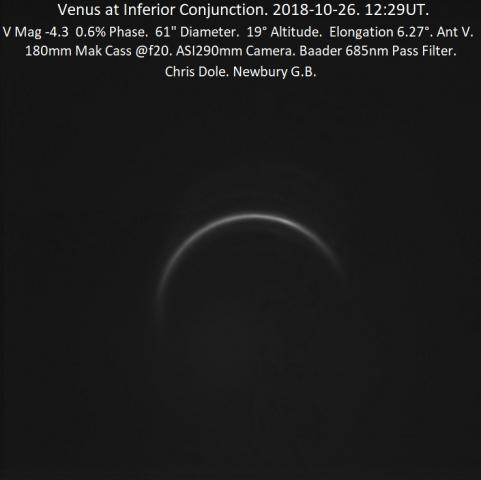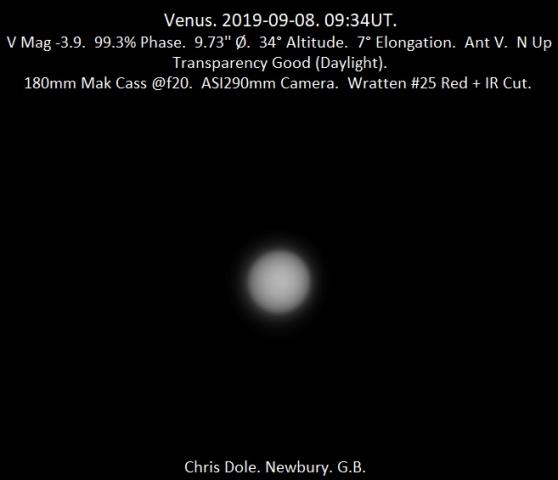- This topic has 6 replies, 5 voices, and was last updated 5 years, 8 months ago by
 Dawson.
Dawson.
-
AuthorPosts
-
11 April 2020 at 10:10 pm #574570
 DawsonParticipant
DawsonParticipantAltitude aside, what is the closest angular separation from the Sun that amateurs can generally image Venus both at apogee and perigee?
Thanks.
James
11 April 2020 at 11:31 pm #582262 Peter GudgeonParticipant
Peter GudgeonParticipantFor perigee, during a transit of Venus. Although I guess that’s not what you meant. 🙂
12 April 2020 at 12:13 am #582264 Chris DoleParticipant
Chris DoleParticipantHi James,
The closest I’ve managed is a tad over 6°. Great care must be taken of course. Seeing conditions are always horrific but I like a challenge!

 12 April 2020 at 8:19 am #582265
12 April 2020 at 8:19 am #582265 DawsonParticipant
DawsonParticipantChris, that is really impressive, thank you. Looking at those dates/times on Stellarium, it is really impressive at how close to the Sun 6 degrees is. Do you take any measures to extend a dew shield of the like to reduce the glare of the Sun into the optics?
James
12 April 2020 at 10:00 am #582266 Alex PrattParticipant
Alex PrattParticipantHi James,
Issue 2014-04 of the Journal for Occultation Astronomy (pp. 13-22) contains an article by Friedhelm Dorst on ‘Observations of Planets and Stars near the Sun’.
We deliberated for some time before deciding to publish it in JOA. We do not condone any attempts to carry out such observations. Observing near the Sun carries high risk to one’s eyesight. It only needs to go wrong once! Even if an observer uses electronic recording techniques, they can be tempted to cast a naked eye glimpse towards the Sun and incur dazzle.
Be careful out there.
Clear skies,
Alex.
12 April 2020 at 10:56 am #582267 David BaseyParticipant
David BaseyParticipantIn the March 1972 issue of Sky and Telescope, A.T. & L.G. Young discuss methods of near Sun observing revolving around keeping the Sun’s light off the primary optics. They cover in some detail the use of tube extensions and occulting disks to achieve this.
They cite the following examples:
- Using the dome to block the Sun, the 82″ reflector at McDonald observatory routinely observed at 12o elongations and down to 7o at reduced aperture.
- Using a sun shield extending 14′ beyond the dome of the 24″ reflector at Table Mountain Observatory, California the authors were able to get down to 4.5o at full aperture and 3o with acceptable aperture loss. This did need an assistant to monitor the shade’s position and adjust as appropriate.
The authors make the point that a solid tube reflector has in effect a built in sun shield.
Certainly it is desirable to keep the Sun off the main mirror for all sorts of reasons. I have a couple of times felt it prudent to curtail observations due to smoke emanating from the end of the telescope tube where an off-axis image of the Sun was burning into the woodwork! Although disconcerting there was no danger to eyesight, being off axis there was no way that the Sun’s image could enter the eyepiece on a Newtonian reflector. This happens quite some distance from the Sun and is a timely reminder that this is close enough. Personally, with my setup, I would consider even 10o too close.
Unless you really know what you are doing like Chris and have suitable equipment, again like Chris, don’t do it. You only have one set of eyes!
David.
12 April 2020 at 11:32 am #582269 DawsonParticipant
DawsonParticipantThanks for all the comments and links. It is fascinating. I’m not intending to image or observe near the Sun, I was just interested to see what sort of results the serious amateur can achieve so close to the Sun. Some of the images in the article Alex links to look far too close for comfort!
Thanks.
James
-
AuthorPosts
- You must be logged in to reply to this topic.
